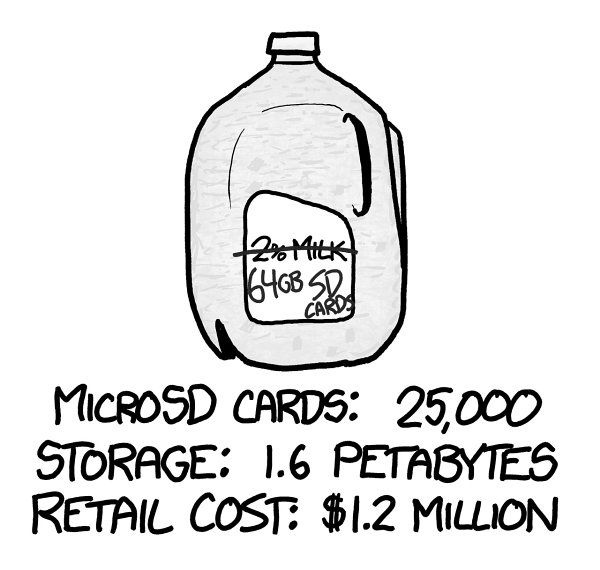What If? (30 page)
Authors: Randall Munroe

Orbital Speed
Q.
What if a spacecraft slowed down on reentry to just a few miles per hour using rocket boosters like the Mars sky crane? Would it negate the need for a heat shield?
—Brian
Q.
Is it possible for a spacecraft to control its reentry in such a way that it avoids the atmospheric compression and thus would not require the expensive (and relatively fragile) heat shield on
the outside?
—Christopher Mallow
Q.
Could a (small) rocket (with payload) be lifted to a high point in the atmosphere where it would only need a small rocket to get to escape velocity?
—Kenny Van de Maele
A.
Th
e answers to these
questions all hinge on the same idea. It’s an idea I’ve touched on in other answers, but right now I want to focus on it specifically:
Th
e reason it’s
hard to get to orbit
isn’t
that space is high up.
It’s hard to get to orbit because you have to go so
fast
.
Space isn’t like this:

Not actual size.
Space is like
this:

You know what, sure, actual size.
Space is about 100 kilometers away.
Th
at’s far away
—
I wouldn’t want to climb a ladder to get there
—
but it isn’t
that
far away. If you’re in Sacramento, Seattle, Canberra, Kolkata, Hyderabad, Phnom Penh, Cairo, Beijing, central Japan, central Sri Lanka, or Portland, space is closer than the sea.
Getting to space is easy.
1
It’s not, like,
something you could do in your car, but it’s not a huge challenge. You could get a person to space with a rocket the size of a telephone pole.
Th
e X-15 aircraft reached space just by going fast and then steering up.
2
,
3

You will go to space today, and then you will quickly come back.
But
getting
to space is easy.
Th
e problem is
staying
there.
Gravity in low Earth orbit is almost as strong as gravity on the surface.
Th
e Space Station hasn’t escaped Earth’s gravity at all; it’s experiencing about 90 percent the pull that we feel on the surface.
To avoid falling back into the atmosphere,
you have to go sideways
really, really fast.
Th
e speed you need to stay in orbit is about 8 kilometers per second.
4
Only a fraction of a rocket’s energy is used to lift up out of the atmosphere; the vast majority of it is used to gain orbital (sideways) speed.
Th
is leads us to the central problem of getting into orbit:
Reaching orbital speed takes much more fuel than reaching orbital height.
Getting a ship up to 8 km/s takes a
lot
of booster rockets. Reaching orbital speed is hard enough; reaching orbital speed while carrying enough fuel to slow back down would be completely impractical.
5
Th
ese outrageous fuel requirements are why every spacecraft entering an atmosphere has braked using a heat shield instead of rockets
—
slamming into the air is the most practical way to slow down.
(And to answer Brian’s question, the Curiosity rover was no exception to this; although it used small rockets to hover when it was near the surface, it first used air-braking to shed the majority of its speed.)
How fast is 8 km/s, anyway?
I think the reason for a lot of confusion about these issues is that when astronauts are in orbit, it doesn’t seem like they’re moving that fast; they
look like they’re drifting slowly over a blue marble.
But 8 km/s is
blisteringly
fast. When you look at the sky near sunset, you can sometimes see the ISS go past . . . and then, 90 minutes later, see it go past again.
6
In those 90 minutes, it’s circled the entire world.
Th
e ISS moves so quickly that if you fired a rifle bullet from one end of a football field,
7
the International Space
Station could cross the length of the field before the bullet traveled 10 yards.
8
Let’s imagine what it would look like if you were speed-walking across the Earth’s surface at 8 km/s.
To get a better sense of the pace at which you’re traveling, let’s use the beat of a song to mark the passage of time.
9
Suppose you started playing the 1988 song by
Th
e Proclaimers, “I’m Gonna Be (500 Miles).”
Th
at song is about 131.9 beats per minute, so imagine that with every beat of the song, you move forward more than 2 miles.
In the time it took to sing the first line of the chorus, you could walk from the Statue of Liberty all the way to the Bronx.

You’d be moving at about 15 subway stops per minute.
It would take you about two lines of the chorus (16 beats of the song) to cross the English Channel between London and France.
Th
e song’s length leads to an odd coincidence.
Th
e interval between the start and the end of “I’m Gonna Be” is 3 minutes and 30 seconds, and the ISS is moving at 7.66 km/s.
Th
is means that
if an astronaut on the ISS listens to “I’m Gonna Be,” in the time between the first beat of the song and the final lines . . .

. . . they will have traveled just about
exactly
1000 miles.
- 1
Specifically, low Earth orbit, which is where the International Space Station is and where shuttles could go.
- 2
Th
e X-15 reached 100 km on two occasions, both when flown by Joe Walker.
- 3
Make sure to remember to steer up and not down, or
you will have a bad time.
- 4
It’s a little less if you’re in the higher region of low Earth orbit.
- 5
Th
is exponential increase is the central problem of rocketry:
Th
e fuel required to increase your speed by 1 km/s multiplies your weight by about 1.4. To get into orbit, you need to increase your speed to 8 km/s, which means you’ll need a
lot of fuel: 1.4 × 1.4 × 1.4 × 1.4 × 1.4 × 1.4 × 1.4 × 1.4 ≈ 15 times the original weight of your ship. - Using a rocket to slow down carries the same problem: Every 1 km/s decrease in speed multiplies your starting mass by that same factor of 1.4. If you want to slow all the way down to zero
—
and drop gently into the atmosphere
—
the fuel requirements multiply your weight by 15 again.
- 6
Th
ere are some good apps and online tools to help you spot the station, along with other neat satellites.
- 7
Either kind.
- 8
Th
is type of play is legal in Australian rules football.
- 9
Using song beats to help measure the passage of time is a technique also used in CPR training, where the
song “Stayin’ Alive” is used.
FedEx Bandwidth
Q.
When
–
if ever
–
will the bandwidth of the Internet surpass that of FedEx?
—Johan Öbrink
Never underestimate the bandwidth of a station wagon full of tapes hurtling down the highway.
–
Andrew Tanenbaum, 1981
A.
If you want to
transfer a few hundred gigabytes of data, it’s generally faster to FedEx a hard drive than to send the files over the Internet.
Th
is
isn’t a new idea—it’s often dubbed “SneakerNet”—and it’s even how Google transfers large amounts of data internally.
But will it always be faster?
Cisco estimates that total Internet traffic currently averages 167 terabits per second. FedEx has a fleet of 654 aircraft with a lift capacity of 26.5 million pounds daily. A solid-state laptop drive weighs about 78 grams and can hold up to
a terabyte.
Th
at means FedEx is capable of transferring 150 exabytes of data per day, or 14 petabits per second
—
almost a hundred times the current throughput of the Internet.
If you don’t care about cost, this 10-kilogram shoebox can hold a lot of Internet.

We can improve the data density even further by using microSD cards:

Th
ose thumbnail-sized flakes have a storage density of up to 160 terabytes per kilogram, which means a FedEx fleet loaded with microSD cards could transfer about 177 petabits per second, or 2 zettabytes per day
—
a thousand times the Internet’s current traffic level. (
Th
e infrastructure would be interesting
—
Google would need to build huge warehouses to hold a massive card-processing
operation.)
Cisco estimates Internet traffic is growing at about 29 percent annually. At that rate, we’ll hit the FedEx point in 2040. Of course, the amount of data we can fit on a drive will have gone up by then, too.
Th
e only way to actually reach the FedEx point is if transfer rates grow much faster than storage rates. In an intuitive sense, this seems unlikely, since storage and transfer
are fundamentally linked
—
all that data is coming from somewhere and going somewhere
—
but there’s no way to predict usage patterns for sure.
While FedEx is big enough to keep up with the next few decades of actual usage, there’s no technological reason we can’t build a connection that beats them on bandwidth.
Th
ere are experimental fiber clusters that can handle over a petabit per second. A
cluster of 200 of those would beat FedEx.
If you recruited the entire US freight industry to move SD cards for you, the throughput would be on the order of 500 exabits
—
half a zettabit
—
per second. To match that transfer rate digitally, you’d need to take half a million of those petabit cables.
So the bottom line is that for raw bandwidth of FedEx, the Internet will probably never beat SneakerNet.
However, the virtually infinite bandwidth of a FedEx-based Internet would come at the cost of 80,000,000-millisecond ping times.

